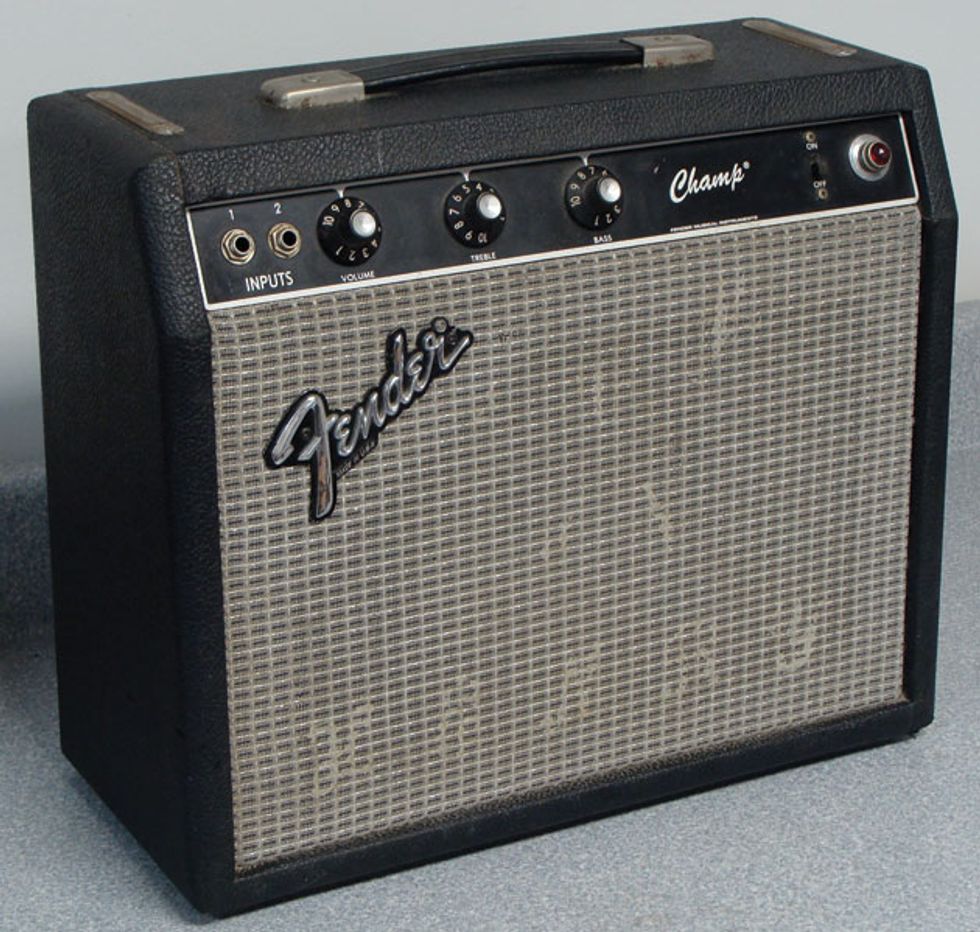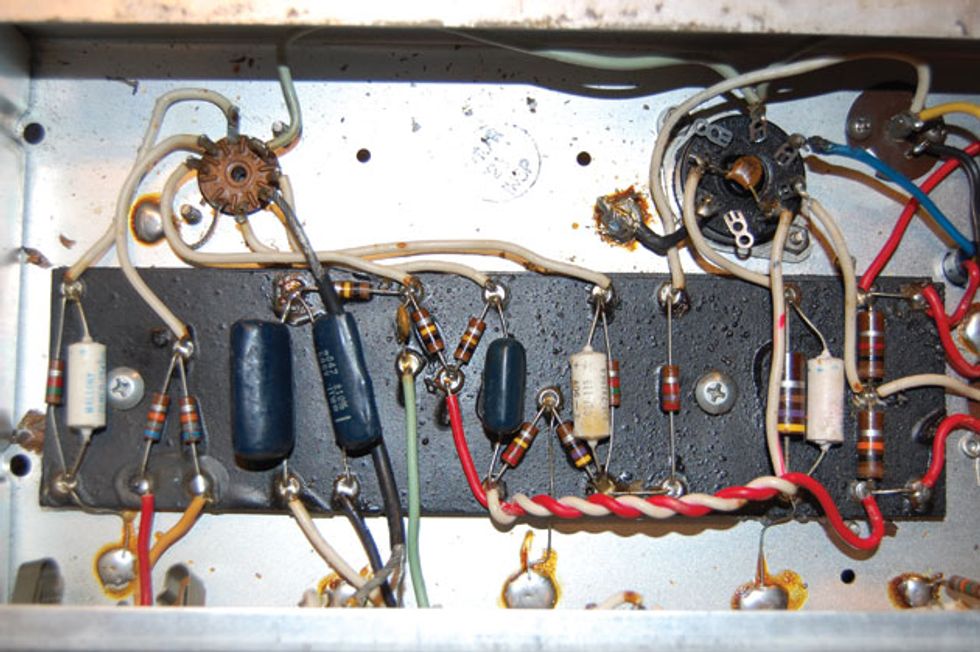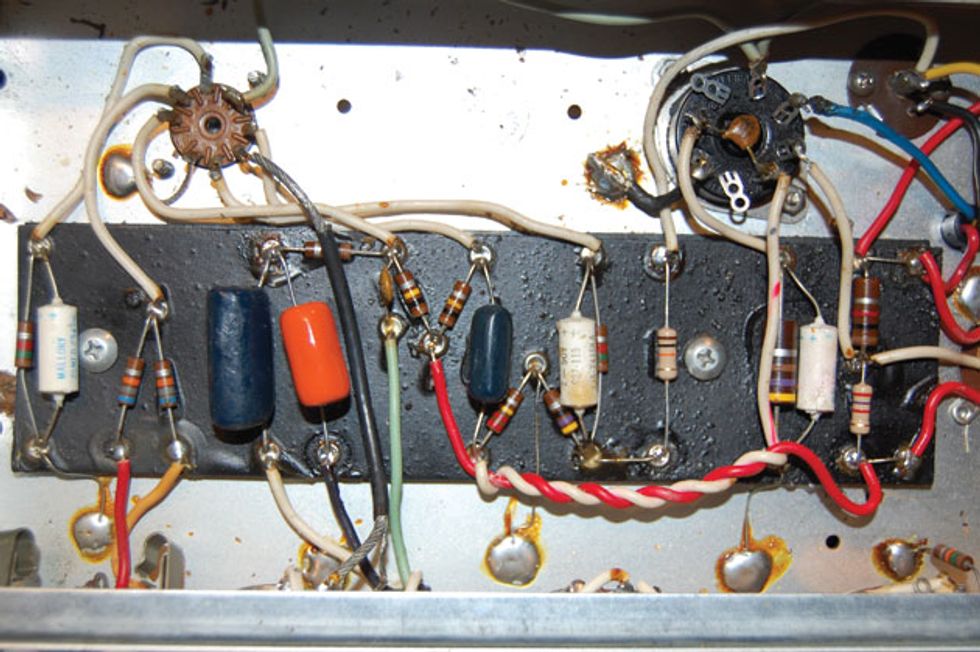I always scroll to your column to see what you’re up to. I was recently given this Fender Champ. She hasn’t been played for six years and she needs a little TLC. I can't really say how she sounds, since the original speaker is shot. (The cone has what looks like a puncture from the power chord.)
I have a replacement Weber speaker, as well as new JJ tubes and Monster Studio Pro 1000 Speaker Cable to install. I know she’s a small combo, but before I take her into the shop, might you have any upgrades/mods to recommend? I play blues-rock à la SRV.
I value your advice! Thanks and rock on.
Matt Alcott
Hi Matt,
Thanks for reading, and thanks for your question.
My first thought was, there’s not really much to modify in such a simple circuit. But then I came up with a couple of cool, simple mods that should have your Champ sounding like no other.
The version of the Fender Champ you own is a bit rare, aesthetically speaking. The original Champ appeared in a tweed version, which was brought into the blackface era around 1964 with a substantially revised circuit. Shortly after CBS bought Fender in 1965, the faceplate was made silver, but the circuit remained unchanged. Then in 1981/82, during Fender’s “Rivera Era,” the Champ faceplate reverted back to black, but again, the circuit was unchanged. This is the model you have. Since this circuit hadn’t been altered since 1964, these simple modifications should pertain to any of the basic 3-knob Champs. So let’s see what we can do.
You mentioned that you play blues-rock à la Stevie Ray. Stevie Ray’s tone was due to a combination of amplifiers, mostly Fenders and Marshalls. (I know firsthand, as I had the fortune—or misfortune—of standing in front of his wall of amps during the late ’80s. These two amp brands have significantly different tone signatures, so the first part of this modification will be an attempt to combine their sounds.
In your amp’s tone stack you’ll find a 0.1 µF and a 0.047 µF capacitor side-by-side on the board, one leg of each connected to a 100k resistor. Remove the 0.047 µF and replace it with a 600V 0.022 µF capacitor. This will give the amp a bit more midrange (the Marshall trait) while leaving intact the Fender-style highs and lows.
The next modification deals with what’s known as the feedback loop. This has nothing to do with guitar feedback—it’s an electrical function that, in this case, keeps the output of the amp as true and clean as possible. But we’re going to change that!
The Champ’s interior before applying the mods.
Near the center of the circuit board you’ll find a 2.7k resistor (color-coded red, violet, red). One end connects to the speaker output, with the other connecting to the phase-inverter circuit. Remove this resistor and replace it with a 10k resistor. (It can be a 1/2-watt resistor as is stock, though I personally prefer using all 1-watt resistors.) This change lets the amplifier saturate more and produce a nicer overdrive when cranked.
The last modification involves the power supply. Towards the mains transformer end of the circuit board are two larger resistors, one positioned above the other. One is a 1k (brown, black, red), and the other is a 10k (brown, black, orange). Remove the 10k and replace it with a 1-watt 2.7k resistor. Decreasing the value of this resistor raises the DC power supply voltage to the first preamp tube, increasing the plate voltage on V1 by approximately 25 volts. This yields a bit less compression and a bit more headroom at the amp’s input, making it sound tighter and punchier. It may also let the amp respond better to pedals.
Here we’ve replaced three components, giving the amp a hybrid Fender/Marshall sound.
Now, keep in mind that these changes won’t make the amp sound like Stevie’s rig or make you sound like SRV. I just used your reference as a jumping-off point to formulate a few simple changes to this basic circuit. That said, if you ever have the opportunity to play this amp next to a stock Fender Champ, I’m pretty sure you’ll notice the difference, and hopefully prefer your amp to the stock model.
A final suggestion: You mentioned that the amp hasn’t been played in six years. I recommend that instead of just powering it up, bring it up slowly using a Variac or similar device so the filter capacitor can be re-formed. This isn’t completely necessary, but it’s nice if you can do it. Then again, you could also just replace the chassis-mounted multi-cap can. Just be ready to break out the big soldering iron for that exercise.
Here’s hoping this gives you a Champ among Champs!
Warning: All tube amplifiers contain lethal voltages. The most dangerous voltages are stored in electrolytic capacitors, even after the amp has been unplugged from the wall. Before you touch anything inside the amp chassis, it’s imperative that these capacitors are discharged. If you are unsure of this procedure, consult your local amp tech.










![Rig Rundown: Russian Circles’ Mike Sullivan [2025]](https://www.premierguitar.com/media-library/youtube.jpg?id=62303631&width=1245&height=700&quality=70&coordinates=0%2C0%2C0%2C0)


























